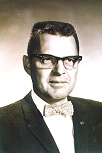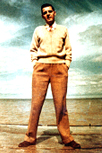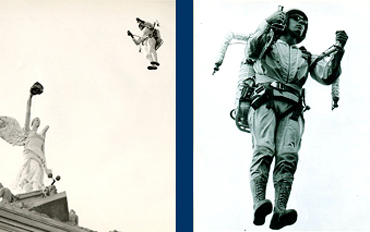 Wendell F. Moore
Wendell F. Moore
liked to wear dark suit,
white starched shirt and
his trademark bowties
Wendell Moore became interested in aviation at a young age after observing a Stearman training aircraft flying near his parents’ house. This simple
bi-plane fueled his imagination leading him –at the age of 15– to design and build his own gasoline model airplane he called "Little Abe".
Wendell had to be different so he ingeniously attached a Brownie box camera to take aerial photographs of his neighborhood. His love of building model aircraft eventually inspired Moore to learn to fly and get his pilot license.
He was educated at the State University of Ohio, in Kent, and Indiana Institute of Technology, in Ft. Wayne, where he studied both aeronautical
engineering and rocket propulsion. During World War II, he was associated with Peerless Corporation of America in Marion Indiana. For that firm, he
designed and built oxygen regulators to enable our World War II bomber pilots to breathe easily at high altitudes. This delicate engineering experience
would provide Moore with the necessary technical background for some of his most important future inventions.
 Wendell aged 20;
Wendell aged 20;
His “Little Abe” gasoline
airplane inspired him
throughout his life.
Wendell (those close to him called him Wendy) came to Bell Aircraft (later named Bell Aerosystems and finally Bell Aerospace in 1966) in 1945, just when a new design study was being implemented by the National Advisory Committee on Aeronautics (NACA later became NASA). This new project designated XS-1 would the portal to human outer-space flight. The XS-1 was an aircraft designed to gather data on the speed transitions of flying from subsonic to supersonic and would –for the first time in American aerospace history– utilize rocket engines in an aircraft to control its speed and attitude. Quickly, Moore and his team set the "experimental R&D” pace for the Bell’s "X-planes" series. They would contribute with their various data and statistics to gain the fundamental experience of how to get a vehicle to maneuver in the vacuum of outer-space.
Shortly after Charles "Chuck" Yeager broke the speed of sound barrier on October 14, 1947 piloting the Bell XS-1 rocket plane, Moore began analyzing the problems associated with high altitude flight, namely the lack of control of an aircraft in a thin atmosphere.
However, it took a near fatal flight for Yeager in the Bell X-1A on December 12 of 1953 before Moore had his concept of reaction control thrusters approved by the NACA. Yeager was trying to break a new altitude record when his Bell Xl-A went into an uncontrolled spin at 75,000 feet. At this height, Yeager lost control of the aircraft because there was no sufficient air to keep the X-1A flying.
He tumbled out of control until reaching an altitude of 25,000 feet where his polished flying skills saved him and the aircraft. After this experience, Moore's inventions of reaction control thrusters were installed into the wing tips and nose areas of high altitude rocket planes. These small retro-rockets would have far reaching implications for human space flight. Wendell Moore eventually helped design the reaction control thrusters for the North American X-15 space-plane, and the NASA’s Mercury, Gemini and Apollo spacecrafts as well. These small control rockets are now in use on every satellite that has ever orbited the earth, moon or planets.
Wendell F. Moore did not stop with his inventions of the reaction control thrusters. In 1956, while working on the Bell X-2 rocket plane project at Edwards Air Force Base in California, he began to draw a picture in the desert sand while standing under the wing of the X-2. A fellow co-worker, Jim Powell, also of Bell Aerosystems, looked and listened to Moore's concept of what would become known as the "rocket belt". Moore had learned of the U.S. Army's Transportation Research Command (TRECOM) interest in finding ways to make troops more mobile. Moore set out to invent a device that could carry a foot soldier over rough terrain or be used for aerial surveillance.

Bill Suitor flies Bell Aerosystems’ Rocketpack Model-B (L) and Gordon Yeager checks his angel wings at the Toronto fairgrounds.
After returning to Bell Aerosystems with his concept in hand, Moore managed to convince Bell administrators to allow him to make an experimental test rig to prove the idea would work. Moore designed and built the nitrogen-gas rig that would be used as a learning platform for how to place and build the different components necessary to make a portable backpack style rocket belt capable of carrying a man into a controlled flight.
After a number of test flights in the nitrogen gas rig, Moore felt confident he could make a rocketbelt and did so, but before he could make an untethered flight in his unique invention he shattered a kneecap in his last tethered flight. Wendell, had initially wanted to be the pilot for a free-flight rocket belt demonstration, but with his knee in such bad shape, he began to look for another test pilot to be the first to fly the machine. Moore would personally train all his rocket belt pilots with extreme care, especially in the area of safety.
The rocket belt would turn out to be "not practical" for military applications due to its limited flight time of only 21 seconds and extreme loud operating noise (131deciBell). However, the concept of flying free as a bird appealed to the movie industry, where the Bell rocket belt would make its mark in history. Demonstrated in over 13 countries worldwide and after many movie (James Bond Thunderball) and television guest appearances (Lost in Space, The Fall Guy, Ark, The A-Team, etc.), the Bell Aerosystems’ rocketeers became instant celebrities.
Wendell Moore's rocket belt concepts grew to include other devices incorporating this technology, such as the one and two-man flying pogos, flying rocket chair and even had the interest of NASA for its lunar transportation program.

